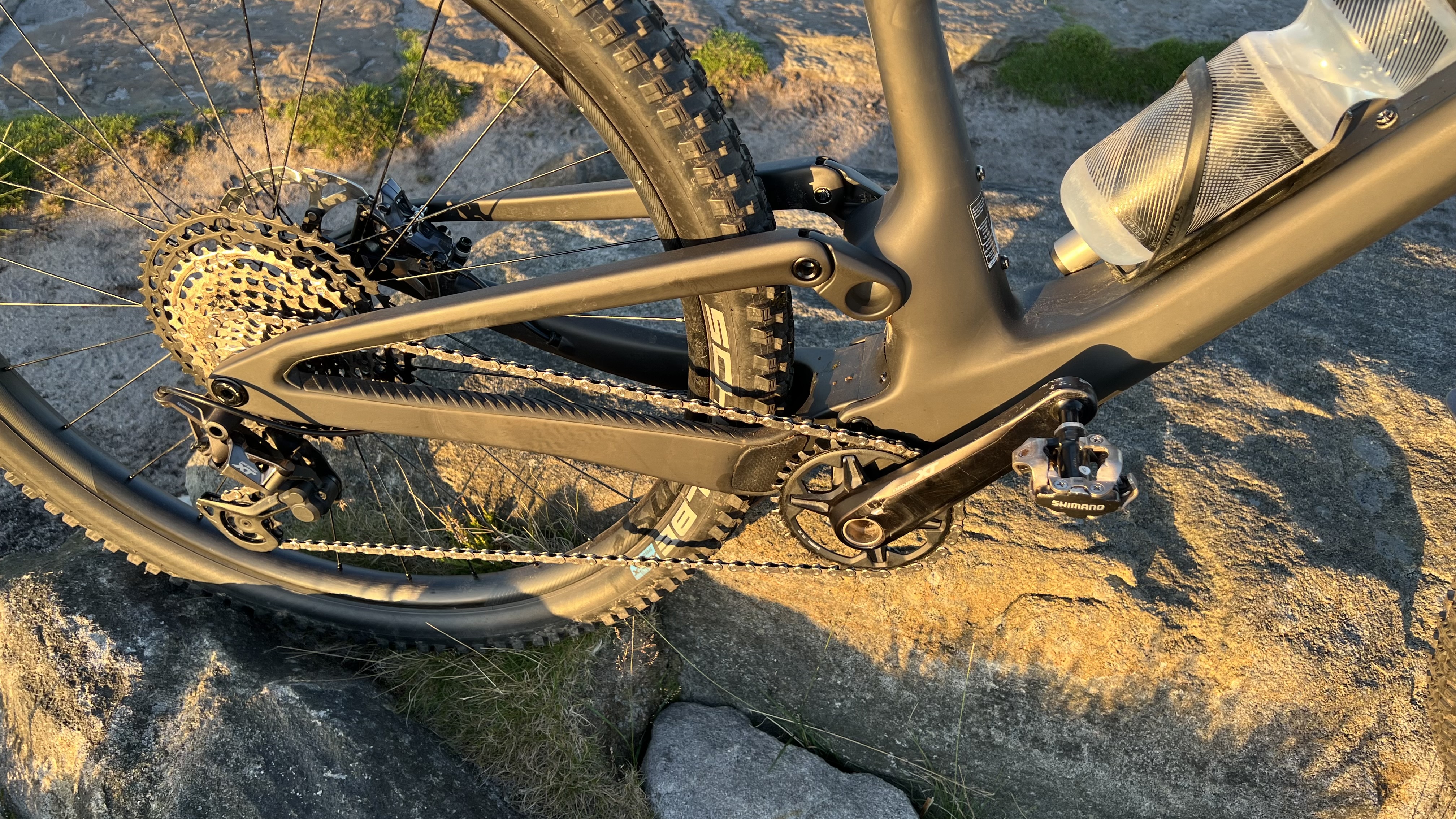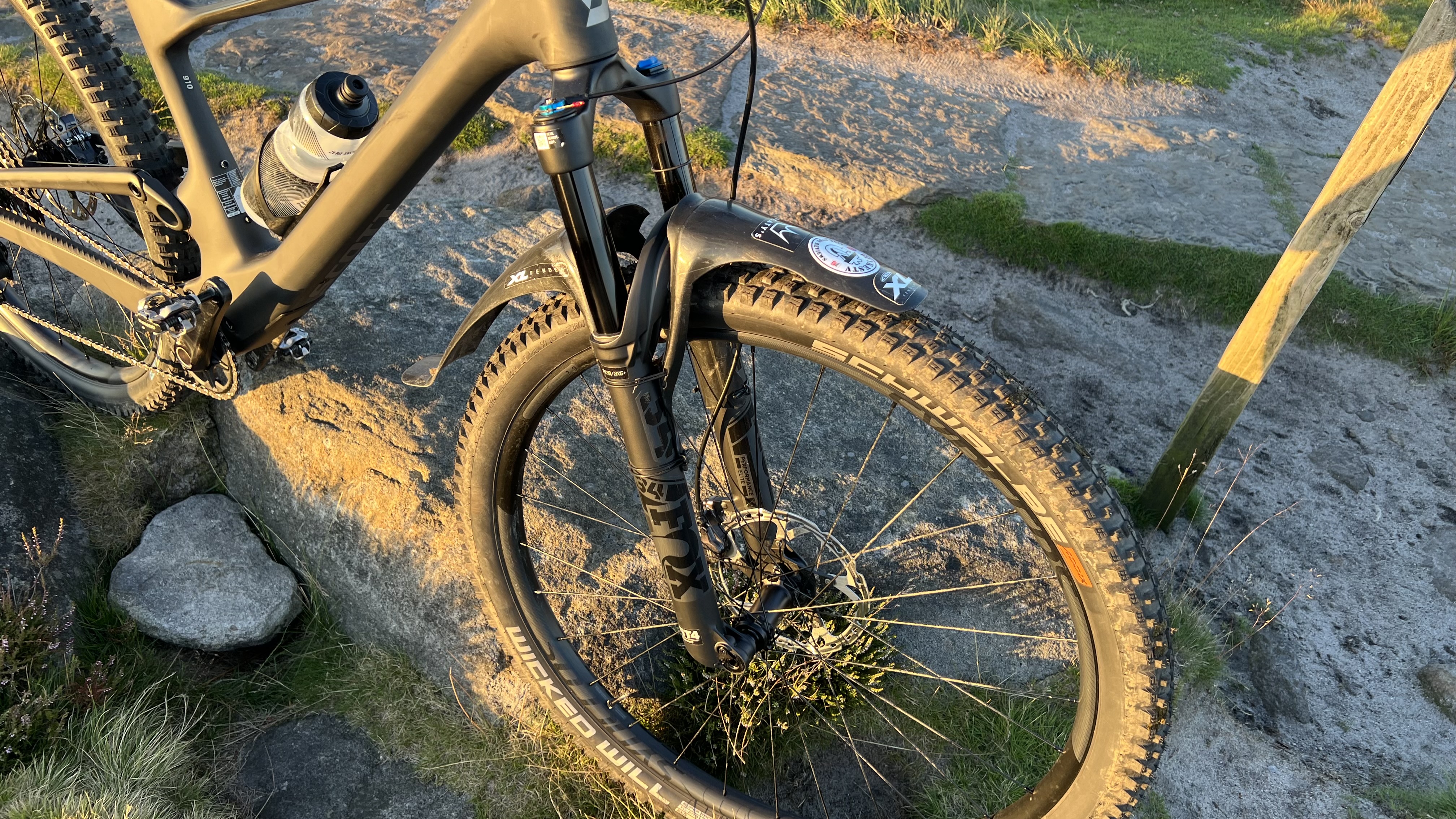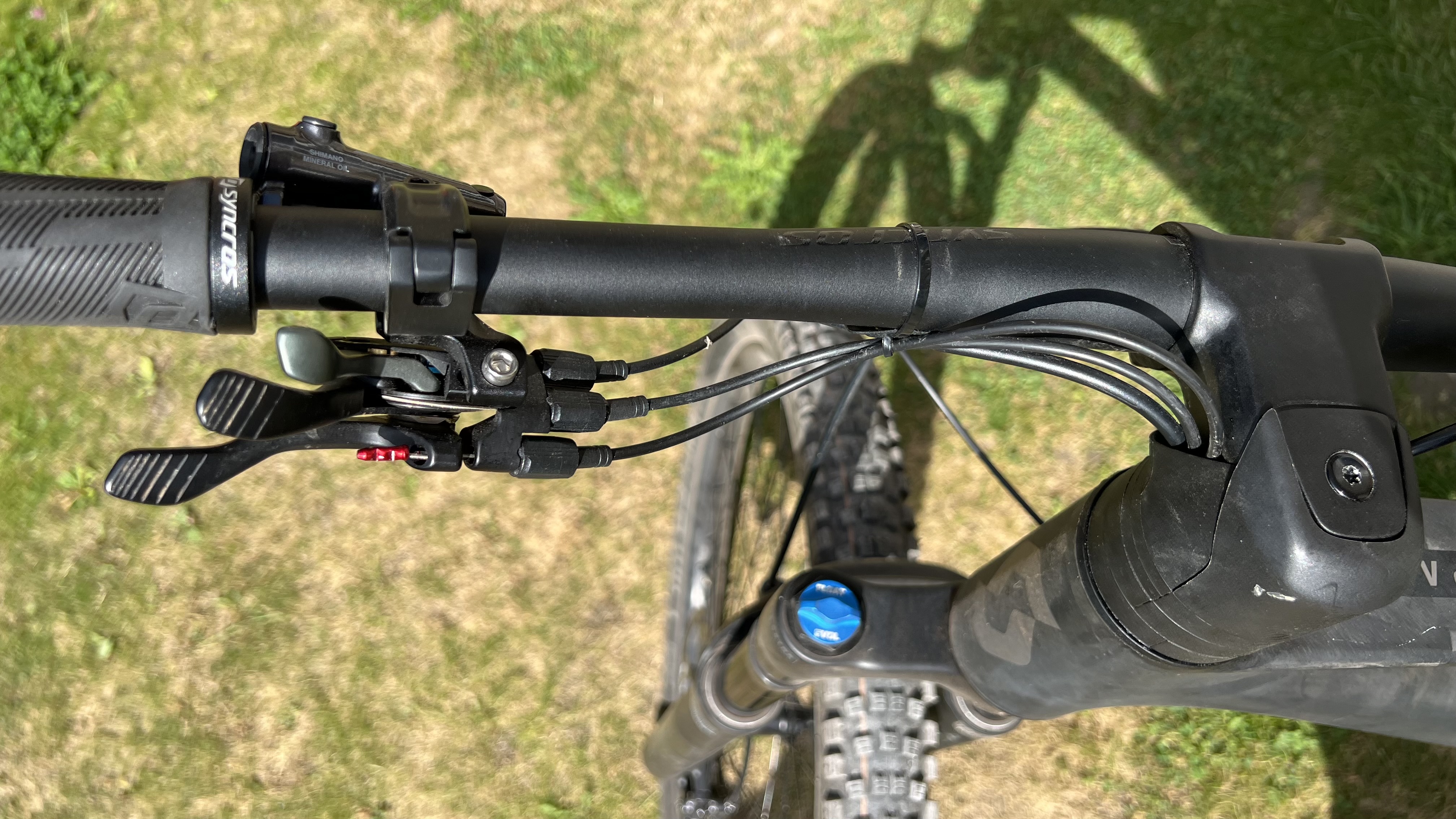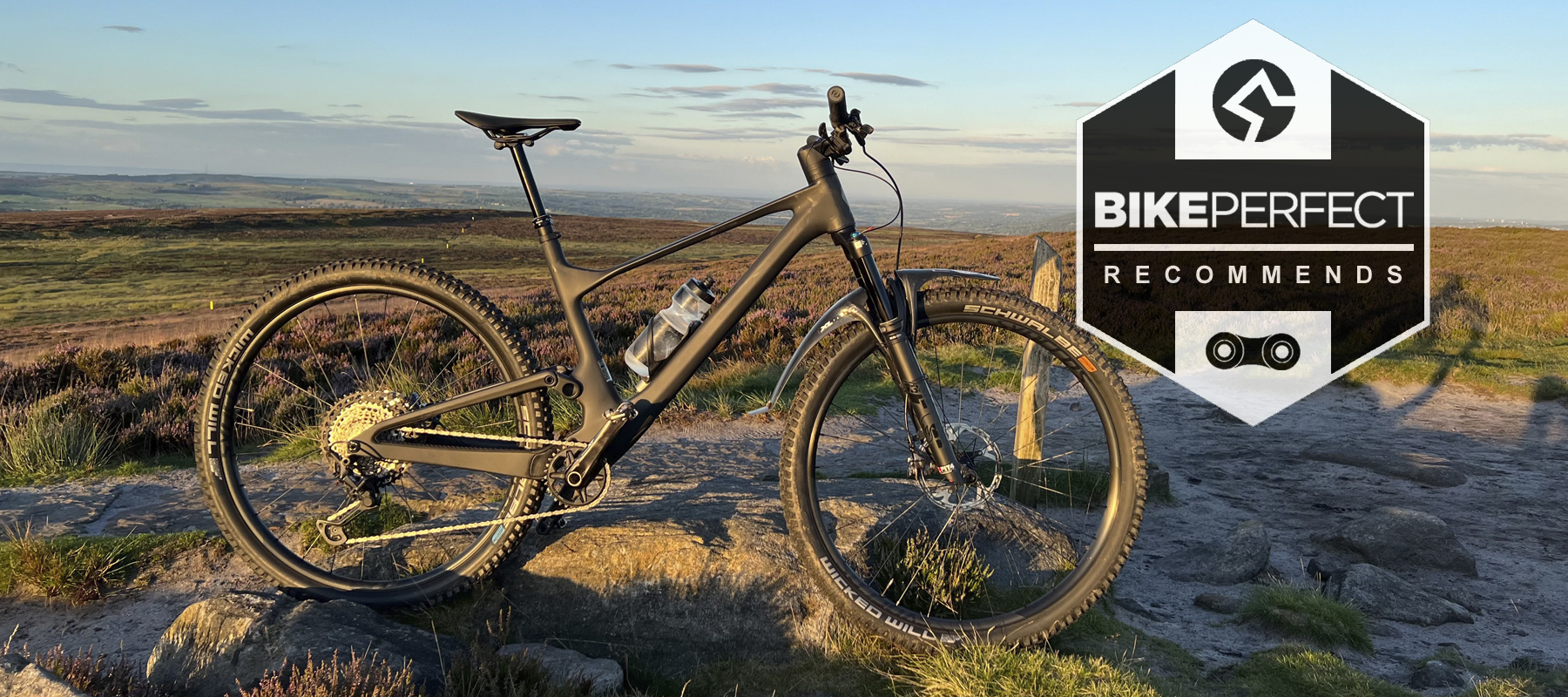Bike Perfect Verdict
Uniquely light, effortlessly efficient and naturally confident ‘downcountry’ crossover with stunning looks and some serious detail, spec and remote shock control smarts that make it potentially perfect for trail riders with a race vibe. The Scott Spark 910 starts getting unbalanced when really pushed hard, though, and too many levers for some.
Pros
- +
Super sleek, stiff and light frame
- +
Low overall bike weight
- +
Excellent Fox 34 and Shimano XT trail spec
- +
Unique Scott multi-mode suspension
- +
Well priced for the tech
Cons
- -
Lots of levers and clattery cables
- -
Front/rear suspension balance is slightly off
- -
Bar is a wonky shape
- -
Suspension creaks after a while
Why trust BikePerfect
The Scott Spark 900 series take one of best full-suspension XC race bike frames and turns it ‘trail’ with the best lightweight trail fork, Shimano’s legendarily tough XT groupset, and custom Schwalbe Wicked Will tires. The result is a uniquely sleek, angle adjustable, remote suspension-equipped, naturally super rapid and well-priced tech that makes a compelling choice of trail raver/racer for those looking for the best trail bike for fast/far riders. Lots of levers and front end suspension bias won’t work for everyone, though.

Design and geometry
The Scott Spark 900 ‘trail’ and RC ‘race’ bikes both use the same Spark 120mm travel frameset with its standout hidden shock looks. Unlike the Bold bikes (Scott now owns the brand), the shock is mounted vertically inside the oversized seat tube base and bottom bracket area. It’s inverted too, with the trunnion bearing head at the bottom for air valve and rebound damping adjuster access behind the latched belly door. Another rubber-capped window on the side lets you see the travel ring for travel/progression measurement. A protractor printed on the frame side works with a line on the shock driver crank to help you set sag percentage too.
The alloy shock cranks attach to the squared seat stays with their carefully engineered flex. The rear brake also sits on a sub mount to stop rotary braking torque from affecting the suspension action. Massive jawbone shaped chain stays assure maximum power transfer from the super wide press fit BB, with a rubber roost skirt bolted across the joint to keep things clean.
The mainframe continues the super stout lower, skinnier upper theme with the flange sided down tube featuring three bottle bolts to give an upper or lower position depending on whether you run a bottle on the seat tube. The top tube tapers rapidly from both ends to create a broad but wafer-thin center section with a conventional external seat post clamp.
For information on Bike Perfect's testing procedures and how our scoring system works, see our how we test page.
The oversized head tube hides a couple of extra tricks too. The rear brake hose, gear and lockout cable are scooped into the plastic shroud around the chunky custom stem routing down through internal channels in the custom spacers and then through the upper headset bearing into the frame. That’s a potential multi unplug and replug control headache when you eventually need to replace that bearing but at least there’s no obvious cable rub on the steerer. Much easier to work with is the eccentric plastic cup holder for the upper headset bearing. Loosening the stem and lifting it along with the spaces lets you rotate the +/- 0.6-degree offset cup through 180-degrees, switching the head angle from 65.8 degrees (default setting) to a steeper 67-degree setting (0.2-degree slacker than the default setting on the RC models). Seat angle stays unchanged at a steep climb-friendly 76.4 degrees with a reach of 470mm on the large model I tested. BB height is 331mm with a chain stay length of 437mm.
The 910 uses the most affordable HMF grade carbon frameset with the heaviest composite lay up giving a 2150g frame, shock and fixtures weight. That compares to 1990g for the HMX lay up and 1870g for the HMX SL. Meanwhile, the Spark 920, 930 and 940 bikes use a 2590g HMF Hybrid (alloy rear end) as well as a full alloy version (2990g).

Components and build
The build spec is a mix of classic trail kit with a couple of Scott specific moves and a useful custom tire treat. Shimano XT has been a trail riding benchmark for 40 years now, and the latest 12-speed version is still a rock solid set-up with damage-proof alloy cranks. Scott has gone for the lighter, twin-piston brakes and you get 180mm rotors front and rear. Fox’s 34 fork is lighter than ever before and the 130mm travel keeps it taut structurally, too.
The FIT4 damper isn’t the smoothest but it’s needed to sync with the triple mode Fox ‘Nude’ rear shock hidden in the frame. While the fork just has three compression modes (Open, Climb, Lock) the rear shock has Open (120mm), Traction (80mm) and locked. Both fork and shock are linked through the same Twin-Loc catch and release remote levers and the lever for the Fox Transfer 150mm dropper post sits underneath. That’s a lot of levers and cables and while they tuck neatly into the stem, the glue on cable guides on the bars had peeled off on our demo and needed to be zip-tied back into place.
The Syncros (Scott house brand) Fraser Low Rise bars are also a really weird shape, so expect to do a lot of twisting to find your sweep/rise sweet spot. We actually ended up with them rotated 90 degrees backwards – according to the logos – to get comfy. Unlike some bespoke internal cable stems you can at least get different lengths or even switch to the carbon all in one Fraser options if you’re feeling fancy. Even if you’re staying with metal the shaped neck spacers and clip on/off cable cowl keeps things looking neat and stop wear on the fork steerer. You can also get a computer mount upgrade for the custom-shaped stem top cap.
The wheels are Syncros ‘Silverton 2.0’ with a 30mm internal rim. Scott have secured an exclusive Schwalbe Wicked Will Addix SpeedSoft compound front tire choice for the Spark 900 bikes for the next couple of years too. The rear is the standard SpeedGrip compound. Interestingly both are the lightest SuperRace 805g carcass with minimal protection, which has positive and negative ride pay-offs as you’ll see. They definitely help keep weight very low for an XT-equipped 120mm at this price (it’s 1.8kg lighter than the Canyon Spectral 125 in XT trim). It’s also only 600g heavier than the £4599 Scott Spark RC Team Issue AXS bike with 120mm SID fork, carbon cockpit and no dropper post.

Ride, handling and performance
That low weight and the fast rolling ramped tread of the tires gives an immediate speed boost to the Scott Spark 910. While freehub engagement isn’t the fastest, it’s got a stiff and urgent feel through the big chainstays, oversized frame belly and broad press fit bottom bracket when you press the pedals. Being able to stiffen or soft lockout the suspension adds two more levels of potential efficiency gains if the surface smoothes out even for just a few meters. That makes the 910 a great choice for trail riders with a racing and/or a hardtail past or those who might be sticking a number on occasionally through the season.
The double bottle position, totally weatherproofed shock and ultra durable Shimano XT spec are all a bonus for long haul riders. But the press fit bottom bracket needs keeping an eye on, and both Spark bikes I’ve put a lot of hours into have developed creaky suspension pivots.
Having ridden the harder rubber Wicked Will a lot, the softer compound exclusive on the Spark is a noticeable win in terms of confidence when cornering or braking in damp, loose or rooty/rocky conditions. Having the slacker head angle as standard increases security in steeper/faster descending situations. There’s none of the frame twist and twang of similar category bikes like the Specialized Epic Evo or the Santa Cruz Blur TR, either. That means once you’ve got the bar set-up sorted it’s a great balance of punchy race style acceleration, very easy speed sustain and trail bike vibes when things get tougher.
The Scott Spark 910 isn't totally convincing when you really start pushing the pace, though, and that’s mainly a front/rear balance issue. While the FIT4 fork has the capability to really charge through rough terrain, you have to push it harder than the same fork with the GRIP2 damper to find that flow. Hard enough that the rear Fox shock starts to show that it’s not quite as sorted when you’re slapping rocks and big roots in the face. While it’s lumpy over high speed impacts and struggles to get full travel, the mid stroke is comparatively wallowy. That meant that I spent a lot of time on rolling, intermediate or even blue/red descent trails with the Spark in the tighter feeling 80mm travel ‘Traction’ setting to keep it sat up and charging.
While being able to flick between modes is great for picking the right setting for every section of trail (I often used it more than the shifter on rise and fall singletrack) it obviously accentuates the differences between each mode. That can be enough to cause a lip wobble at that point of an epic or flat-out ride where things are already getting emotional, especially as the basic suspension architecture is really well balanced and doesn’t really need a remote – just a slightly different tune.
The remote cable means there’s no way to adjust the low-speed damping either. And – this is potentially a major point to be hidden down the end of a paragraph on dampers – for some people the whole triple-lever stack will just be a distracting eyesore and unwanted extra weight. Especially on a bike that’s otherwise spectacularly sleek and impressively light.
Rear tire pressure needs keeping high (we were running up to 25psi rather than our normal sub 20psi) to stop the lightweight SuperRace carcass squirming around. Happily it’s supple enough not to feel bad blown up hard though and so far it’s actually proved tougher than the 100g heavier SuperTrail.
As a small but potentially significant aside the amount of noise the rear gear cable makes rattling round in the frame is very obvious – especially compared to the silent AXS wireless gear-equipped Spark RC bikes we’ve tested.

Verdict
Direct comparison with the Spark RC on the trail was a very interesting part of the testing we did too – in a surprising way. The Spark 910 has a definite edge over a lot of other 120/130mm trail bikes in terms of effortless speed, weight and mode-switching suspension efficiency (if you like that sort of thing). I know exactly the sort of riders who’ll be looking at the all black raw aesthetic, the XT groupset, Fox 34 fork, proper dropper and special edition front tire and thinking Scott have built their dream bike too. And for many of them, they really have. It’s good value for a bike you can get through a proper shop and has some really delicious, premium design elements too.
Just be aware that if you really start pushing hard, it’s hanging on to – rather than hanging – other heavier competitors in its travel category. Interestingly timed laps around even super janky, rock and choke red (with bits of black) trails showed that - if you’re prepared to really commit - the RockShox equipped RC version (with a dropper added) was actually fractionally faster on descents and significantly faster on climbs than this 910.
Test conditions
Temperature: 12-30°C
Surface: Full rock and mud slide enduro trails, off piste moorland singletrack, black/red/blue trail center laps.
Tech Specs: Scott Spark 910
Discipline: XC/DC/Trail
Price: £5299
Head angle: 65.8°/67°
Frame material: Scott HMF carbon
Size: L
Weight: 12.4kg
Wheel size: 29x2.4in
Suspension (front / rear): Fox 34 Performance Elite FIT4 130mm travel, 44mm offset / Fox Float NUDE 5T EVOL 120/80mm travel
Components: Shimano XT 8100 12 speed mech, 11-51T cassette and shifter; Truvativ Descendant 30T chainset; Shimano XT brakes with 180mm rotors; Schwalbe Wicked Will Addix Speed Soft SuperRace 29 x 2.4in front and Schwalbe Wicked Will Addix Speed Grip SuperRace 29 x 2.4in rear tires on Syncros Silverton 2.0 30mm rim wheels; Syncros Fraser 1.5 DC Alloy 760mm riser bar and Syncros DC 1.5 60mm stem; FOX Transfer Performance Elite 150mm Dropper Post; Syncros Tofino 1.5 Regular saddle.

Guy Kesteven has been working on Bike Perfect since its launch in 2019. He started writing and testing for bike mags in 1996. Since then he’s written several million words about several thousand test bikes and a ridiculous amount of riding gear. He’s also penned a handful of bike-related books and he reviews MTBs over on YouTube.
Current rides: Cervelo ZFS-5, Specialized Chisel, custom Nicolai enduro tandem, Landescape/Swallow custom gravel tandem
Height: 180cm
Weight: 69kg

